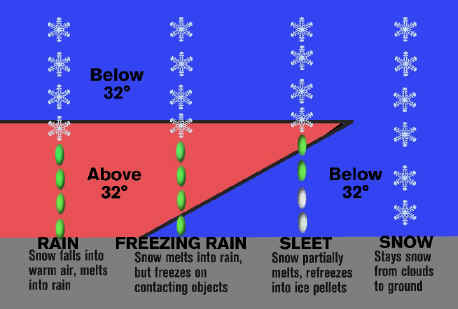
Look at the figure above. Sometimes there is a layer of air in the clouds that is above freezing, or 32 degrees F. Then closer to the ground the air temperature is once again below freezing. Snowflakes partially melt in the layer of warmer air, but then freeze again in the cold air near the ground. This kind of precipitation is called sleet. It bounces when it hits the ground. If snowflakes completely melt in the warmer air, but temperatures are below freezing near the ground, rain may freeze on contact with the ground or the streets. This is called freezing rain, and a significant freezing rain is called an ice storm. Ice storms are extremely dangerous because the layer of ice on the streets can cause traffic accidents. Ice can also build up on tree branches and power lines, causing them to break and our lights to go out. There is another kind of precipitation that comes from thunderstorms called hail. Go here for more about it.
Experiment:
Be a Tropical Rain Maker!
Try this experiment, but only with adult supervision:
Boil water in a tea kettle. Watch the steam come out and go into the air. (Evaporation)
Put ice in a metal pie pan. Hold the pan over the steam and watch the drops form on the bottom of the pan. (Condensation)
As the drops grow in size, they will get heavy and start to fall. (Precipitation)
Go to Next Page
©Copyright 2004 Nick Walker/Small Gate Media